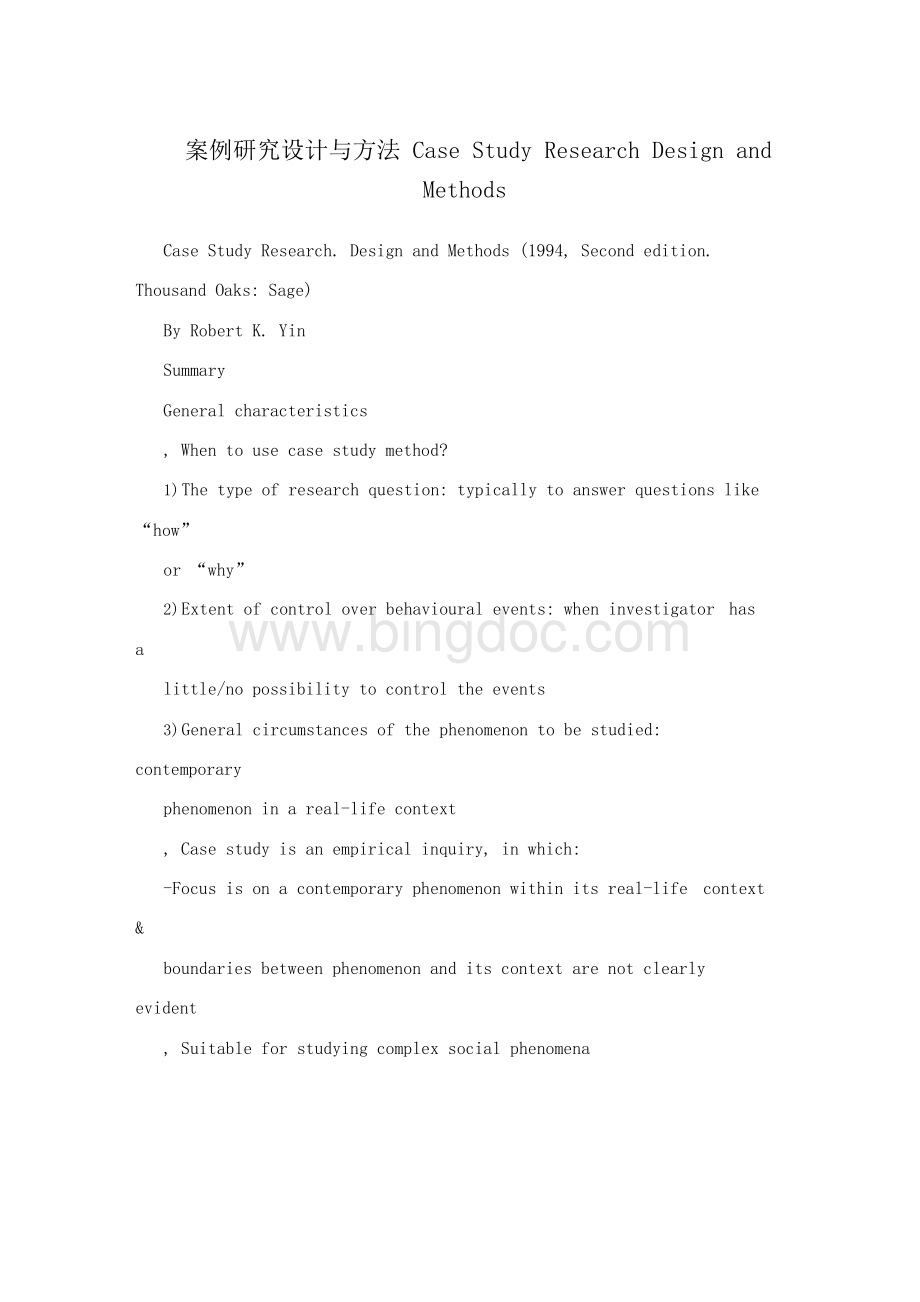案例研究设计与方法Case Study Research Design and MethodsWord下载.docx
《案例研究设计与方法Case Study Research Design and MethodsWord下载.docx》由会员分享,可在线阅读,更多相关《案例研究设计与方法Case Study Research Design and MethodsWord下载.docx(13页珍藏版)》请在冰点文库上搜索。

boundariesbetweenphenomenonanditscontextarenotclearlyevident
Suitableforstudyingcomplexsocialphenomena
-Proceduralcharacteristicsinthesituationinclude:
Manyvariablesof
interest;
multiplesourcesofevidence;
theoreticalpropositionstoguidethe
collectionandanalysisofdata
-Typesofcasestudiesmightbe:
explanatory;
exploratory;
descriptive
-Designscanbesingle-ormultiple-casestudies
-Usedmethodscanbequalitative,quantitative,orboth
Typicalcriticismstowardscasestudies&
correctinganswers:
-Lackofsystematichandlingofdata->
Systematicreportingofallevidence
-Nobasisforscientificgeneralization->
Purposeistogeneralizetotheoretical
propositions,nottopopulationasinstatisticalresearch
-Taketoolong,endupwithunreadabledocuments->
Timelimits&
writing
formuladependonthechoicesofinvestigatorsCasestudyresearchdesign
Centralcomponentsofacasestudydesign&
theirfunctions:
1)Astudy’squestions–“how”,“why”
2)Study’s(theoretical)propositions–pointingattention,limitingscope,
suggestingpossiblelinksbetweenphenomena
3)Study’sunitsofanalysis–mainunitsmustbeatthesamelevelasthe
studyquestions&
typicallycomparabletothosepreviouslystudied4)Logiclinkingthedatatothepropositions–matchingpiecesofinformationtorivalpatternsthatcanbederivedfromthe
propositions
5)Criteriaforinterpretingthefindings–iterationbetweenpropositions
anddata,matchingsufficientlycontrastingrivalpatternstodata;
there
isnoprecisewayofsettingthecriteria1
Researchdesignlinksthedatatobecollectedandconclusionstobedrawntothe
initialquestionsofthestudy–itprovidesaconceptualframework&
anactionplan
forgettingfromquestionstosetofconclusions.
Preliminarytheory&
blueprintofthestudy:
havingsolvedthefivesteps
mentionedaboveleadstotheformationofaloosetheory&
ablueprintrelated
tothetopicofstudy
-Initialtheory&
understandingofwhatisbeingstudiedisnecessary
beforeanyfieldcontacts;
thecompleteresearchdesignembodiesa“theory”
ofwhatisbeingstudied
Decidingbetweenexplanatory,exploratoryanddescriptivedesigns:
-Dependsontherichnessoftherivalpropositionsintheoriesrelatedtothe
topicofthestudy;
richesttheoriesallowexplanatorydesigns
->
Searchfortheoreticalpropositionsthatcanbeelaboratedtocoverstudy
questions,propositions,unitsofanalysis,data-propositionlinks&
criteriaof
interpretation
Reviewingliterature,discussingwithinvestigators,askingchallenging
questions,thinkingwhatistobelearnedfromthestudy
Beingawareoftherangeoftheories&
selectingtherequiredlevel
(individual,organization,societal)
Constructionofthedesign/conceptualframeworktakestime&
canbe
difficult,butisacrucialstepforthesuccessofthestudy
Selectionofthecases:
-Casesshouldbeselectedinthesamewayasthetopicofanexperimentis
selected
Developedpreliminarytheoryisusedasatemplatewithwhichtocompare
thecharacteristics&
empiricalfindingsfromthecase(s)
Selectedcasesshouldreflectcharacteristics&
problemsidentifiedinthe
underlyingtheoreticalpropositions/conceptualframework
Thelevelofgeneralizationofthestudyresults=appropriatelydeveloped
preliminarytheory/studydesign
-Modeofgeneralization=theory-relatedanalyticgeneralization,not
statistical
-AnalyticgeneralizationpossiblefromoneormorecasesHOWMANYOFCASES&
UNITSOFANALYSIS?
1)Case–representssomehowtheinterestingtopicofthestudyempirically(e.g.
theroleoftheUnitedStatesintheworldeconomy)2)Unitofanalysis–istheactualsourceofinformation:
individual,
organizationaldocument,artifact,forexample(e.g.thecapitalflowbetween
countries,aneconomicpolicy)1)Cases:
A)Singlecases–ifcaseseemstorepresentacriticaltesttoexistingtheory;
rareoruniqueevents->
Importanttoselectcase&
unitofanalysisproperly
2
B)Multiplecases–ifa“replicationlogic”issupposedtorevealsupportfortheoretically
i.Similarresults
ii.Contrastingresultsforpredictablereasons
Theoreticalframeworkmustidentifyclearlytheconditions,when
particularphenomenonislikelytobefound(i.)andwhenitisnotlikely(ii.)
Theoreticalframeworkisthevehicleforgeneralizingtonewcases;
if
empiricalcasesdonotworkaspredicted,modificationsmustbemadetothe
theory
Numberofcasereplicationsdependsuponthecertaintywantedtoachieve
richnessoftheunderlyingtheoreticalpropositions2)Unitsofanalysis:
A)Holisticdesigns–includeasingleunitofanalysis;
ifaimistostudytheglobalnatureofthephenomenon;
whennologicalsub-unitscanbepointed->
dangerofabstractness
B)Embeddeddesigns–includemultipleunitsofanalysis;
studymayinclude
main&
smallerunitsondifferentlevels->
lookingforconsistentpatternsof
evidenceacrossunits,butwithinacase
Note:
Theflexibilityofcasestudydesignisinselectingcasesdifferentfrom
thoseinitiallyidentified,notinchangingthepurposeorobjectivesofthe
studytosuitthecasesConductingcasestudies
Desiredskillsoftheinvestigator:
-Goodknowledgeofthephenomenon(->
collectionproceduresarenotroutinized)
-Sensitivityfornovel&
unexpectedissuesindatacollection
-Askinggoodquestions
-Beingagood“listener”-Adaptiveness&
flexibility
Acasestudyprotocolshouldbeessentialpartofeverycasestudyproject-Aprotocolcontainstheinstrumentfortheresearch,butalsotheprocedures
andgeneralrulesthatshoudbefollowedusingtheinstrument:
-Overviewofthestudyproject(objectives,issues,readings,literature&
research)
-Fieldprocedures(accesstofieldsites,sourcesofinformation)
-CasestudyquestionsposedtoINVESTIGATORS;
key
classifications;
suggestionsforlikelysourcesofevidence(nottheliteralquestionstobeasked)
-Aguideforthecasestudyreport
-Note:
Casestudyprotocolshouldbeco-authoredbyallstudyinvestigators
Importanttoidentifydifferentlevelsofquestions:
A)Singlecase-level
1.Questionsaskedofspecificinterviewees3
2.QuestionsaskedoftheindividualcaseB)Moregenerallevels
1.Findingsacrossmultiplecases
2.Findingsacrossanentirestudy(includingreviewedliterature)3.Normativequestionsaboutpolicyrecommendations&
conclusions
SometimesapilotstudymayprovideusefulhelpCollectingtheevidence
Sixsourcesofevidence:
1)Documents(letters,agendas,progressreports)
2)Archivalrecords(Servicerecords,organizationalcharts,budgetsetc.)
3)Interviews(typicallyopen-ended,butalsofocused,structured&
surveysarepossible)
4)Directobservations(formalorcasual;
usefultohavemultipleobservers)
5)Participantobservation(assumingaroleinthesituation&
gettingan
insideviewoftheevents)6)Physicalartefacts
Threeprinciplesofdatacollection:
1)Usemultiplesourcesofevidence
-Triangulation=searchingconvergingfindingsfromdifferentsources->
increasesconstructvalidity
2)Createacasestudydatabase
-Adatabaseseparatefromthefinalreporttobewritten,containing
-Casestudynotes(clear&
availableforlateruse)
-Casestudydocuments
-Tabularmaterials(collected&
created)
-Narratives(initialopen-endedanswerstothestudyquestionssuggestedbyinvestigators)
3)Maintainachainofevidence
Thelinkbetweeninitialstudyquestionsandcasestudyprocedure
shouldbepointedoutinthecasestudyprotocol,asalsothecircumstances
oftheevidencetobecollected
Puttingthedatacollectiontopracticeonthebasisoftheprotocol
Actualevidencestorageinthedatabaseforlaterchecks(specific
collectioncircumstancesindicated)
Sufficientcitingofthecasestudydatabase&
evidenceinthefinal
reportandconclusionstobedrawnAnalysingtheevidence
Analysisofevidenceisonetheleastdevelopedandmostdifficultaspectsofdoing
casestudies.Mostimportantistohaveageneralanalyticstrategy,whichhelpsto
chooseamongdifferenttechniques.Inabsencepreliminarytechniques–matrixes,
4
tabulationoffrequencies,temporalschemesetc.–canbetriedouttogettheanalysis
started.
Twogeneralanalyticstrategies:
1)Relyingontheoreticalpropositions:
theoreticalorientationguiding
theanalysis;
followingtheoreticalpropositionsthathaveformedthe
designofthecasestudy->
helpstofocusattentiononcertaindata
toignoreotherdata
2)Developingacasedescription:
adescriptiveframeworkfororganizingthecasestudy;
analysisorganizedon